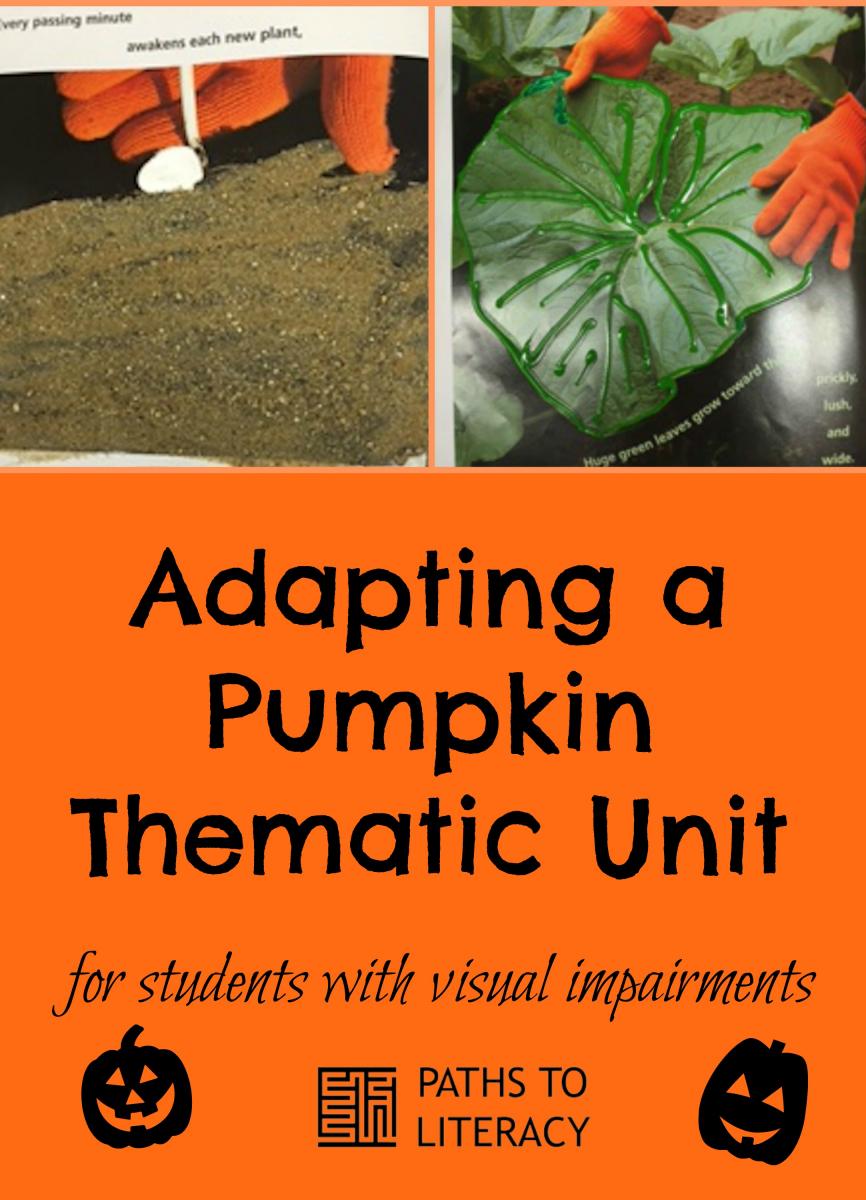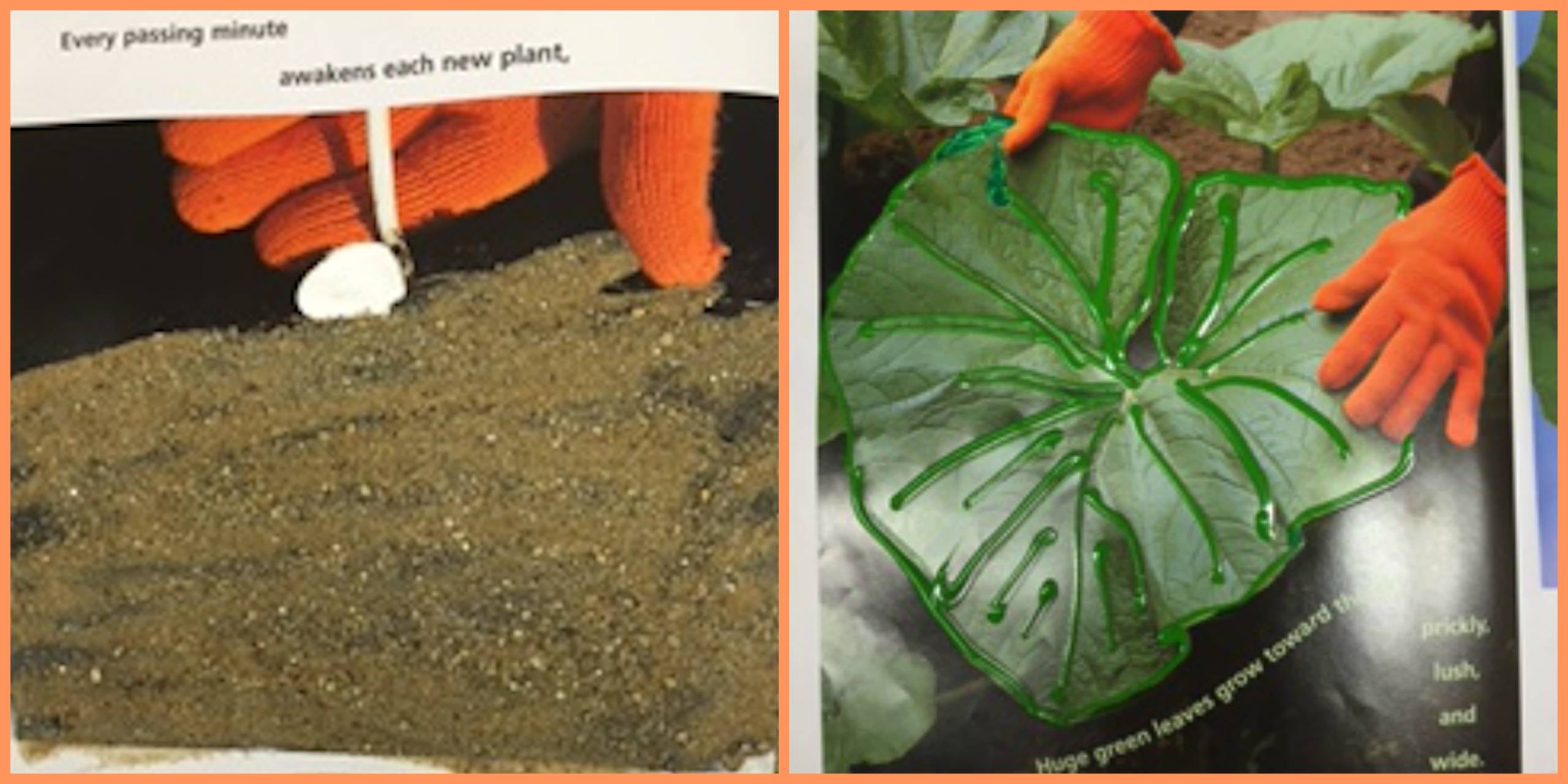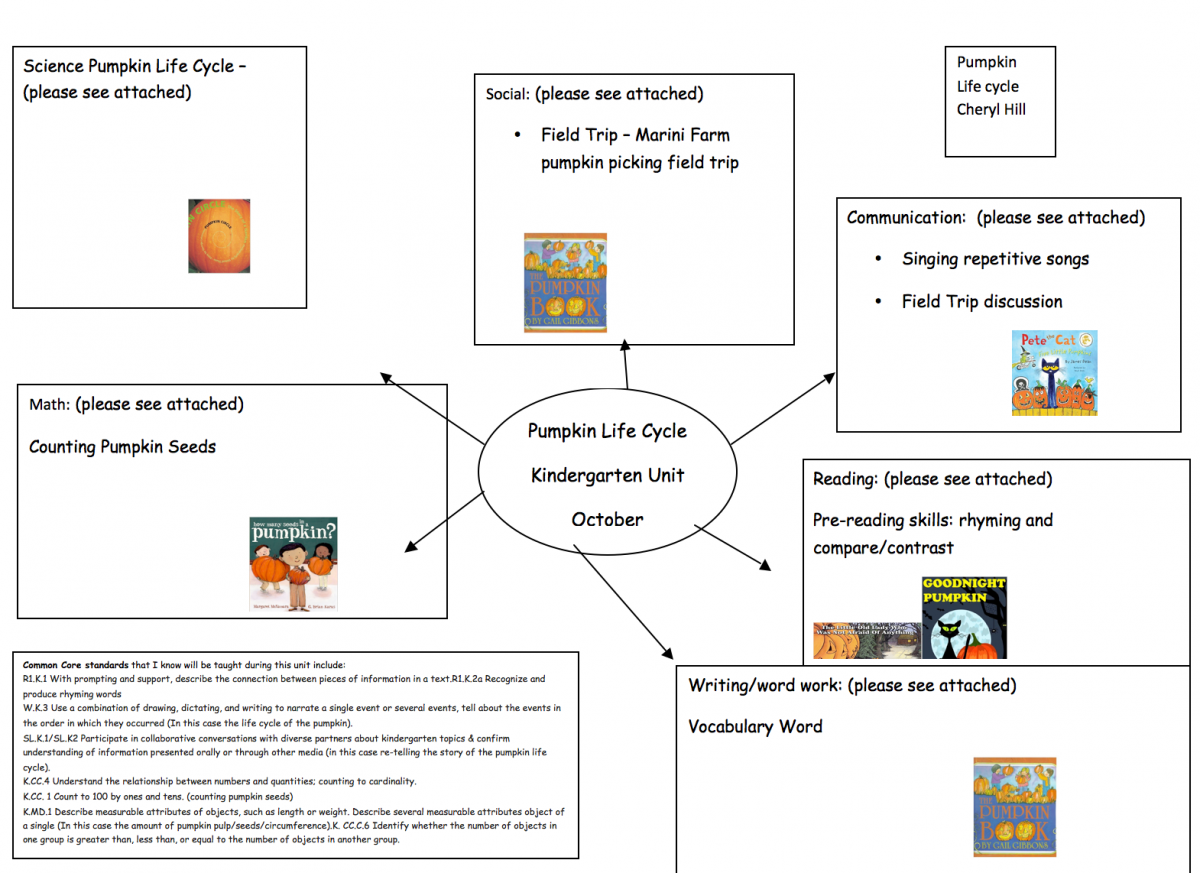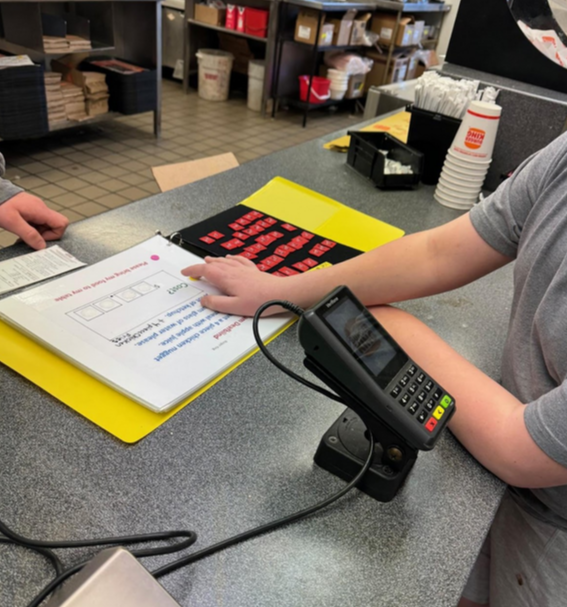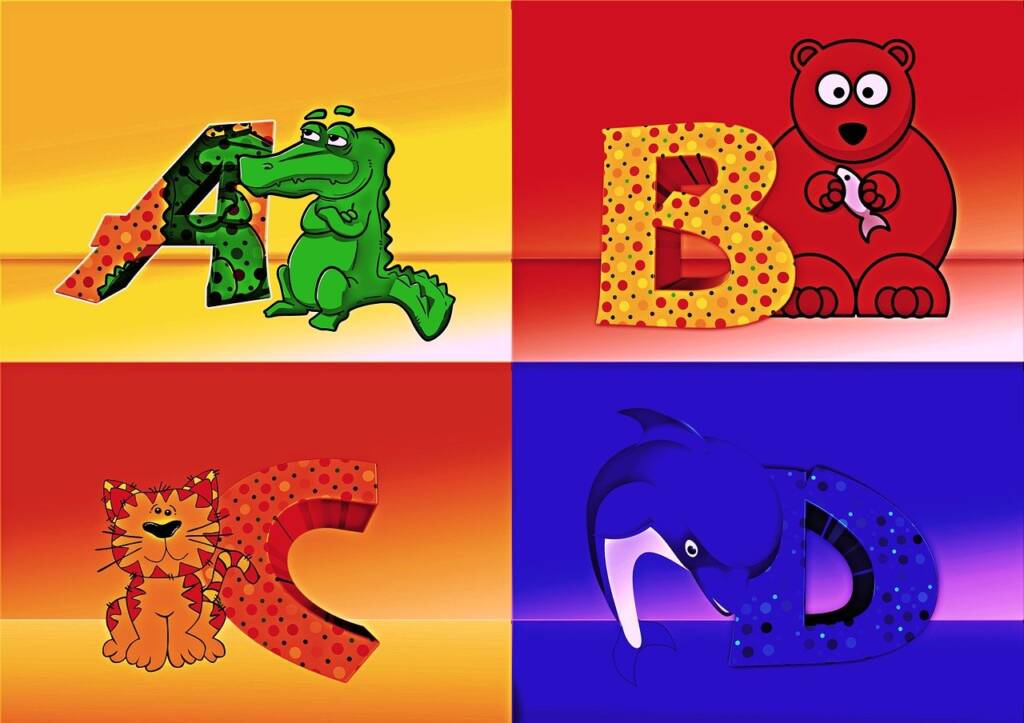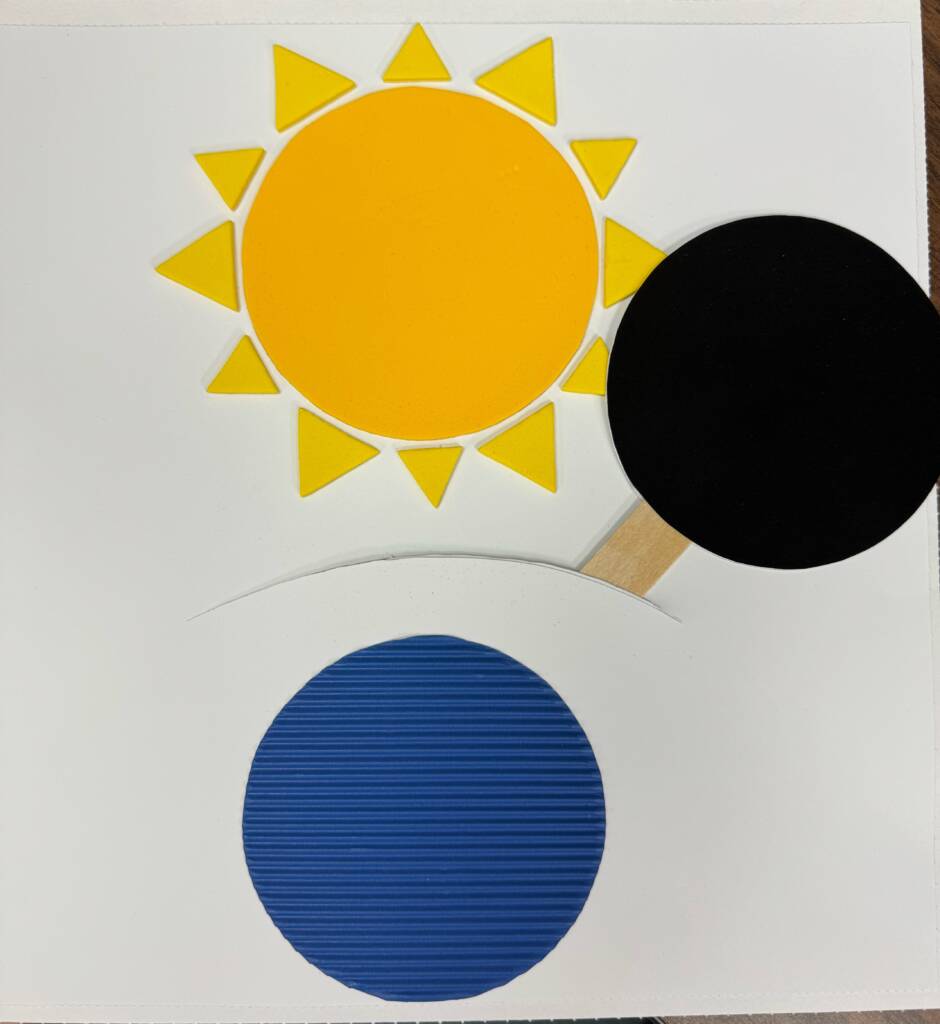I teach a unit on the Pumpkin Life Cycle during the month of October in my typically developing Kindergarten class. This year I have 23 students in my class, one of whom is visually impaired, one who is on the Autism Spectrum, one ELL student and one who is on an IEP for speech and language support.
I have made modifications and adapted materials for my student who is visually impaired, but I believe these modifications will help ALL my students.
Some of the books I plan to read during the unit include:
-
Pete the Cat: Five Little Pumpkins by James Dean
-
How Many Seeds in a Pumpkin? by Margaret McNamara
-
The Little Old Lady Who Was Not Afraid of Anything by Linda Williams
-
Goodnight Pumpkin by Sharlene Alexander
-
Pumpkin Circle: The Story of a Garden by George Levenson
-
The Pumpkin Book by Gail Gibbons

Social Skills/Concept Development
 Marini Farms field trip: Mr. Marini will pick us up on the tractor/hayride and we will travel to Marini Farm (about 1 mile).
Marini Farms field trip: Mr. Marini will pick us up on the tractor/hayride and we will travel to Marini Farm (about 1 mile).
As we are on the hayride, be sure to remind and model respectful listening and taking turns.
- How the ride feels (bumpy on the field, smooth on the road).
- Sounds we may hear (other cars, birds).
- When we have the window open in a car we feel wind. Discuss why we don’t feel wind (we are moving too slowly).
- How do you feel when you are behind Mr. Marini’s tractor when you are late for soccer?
- How do you feel now that there are cars behind us and we are having fun on the tractor?
Enjoy being on the working farm all morning. Pick pumpkins – discuss pumpkin patch.
- How is a “patch” different from an orchard?
- How do the pumpkins grow?
- What do you remember about The Pumpkin Book by Gail Gibbons?
- Is there anything that surprised you?
Experience and Experience Book
This is a fun field trip! Students love being on the road and being on an open hayride (with no car seats!). Picking pumpkins at the pumpkin patch is so much fun and actually seeing the pumpkins grow on a vine really helps students understand the difference between apples growing on a tree (we also go to an apple orchard) and pumpkins growing on a vine.
When we return to school we will make an experience book. As I walk around on the field trip, I will put “reminders” in my backpack. I will put some wet muddy soil from the pumpkin patch (I will have baggies ready.), a piece of the actual vine (being sure I have some of the prickles so students can remember the vines were not smooth), pumpkin seeds, hay from the hayride, etc.
We will actually create the book together. I will use predictable text with “word wall words”: I see a ________.
I will use my braille labeler to also add braille under the large letters.
Communication Skills
I believe that speaking and sharing is the first step in teaching students to read and write. I provide time for active discussions every day. I teach students to take turns and to be respectful. After one of my “friends” talk, I encourage others to ask questions and add comments.
We also discuss “schema”. I model this from the very first day of school. “Oh Wow – that sounds so fun. It reminds me of when my daughters and I….” (The first step to being able to make connections as they read.)
I believe that students need time to talk and share. I am very shy speaking in a group. It is my hope that if students feel comfortable at a young age with no risk that they will be more comfortable/confident later in life.
Sing Repetitive Songs
Pete the Cat is a favorite in our class. There are many Pete the Cat books with accompanying CD. The CD has fun music in the background as well as a song woven into the story. Students enjoy singing the song at the appropriate parts.
- After reading the book, we will discuss how our trip to Marini Farms is different than Pete the Cat’s trip to the pumpkin patch.
- How were the two trips the same?
- Remind students as we have class discussion to have respectful listening.
Reading and Pre-Reading
-
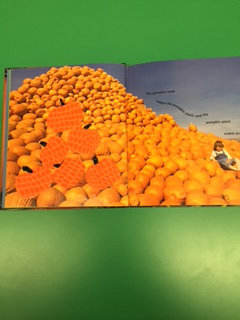 Students listen to the stories Goodnight Pumpkin and Goodnight Moon.
Students listen to the stories Goodnight Pumpkin and Goodnight Moon.
- Discuss: How are they the same? How are they different?
- Begin to discuss a Venn diagram. I use Venn diagrams often to illustrate comparisons. I will adapt this by using hula-hoops. I will have a story box for each book.
- I have a large dollhouse with an entire tub full of manipulatives to go with the dollhouse. I think I will be able to pull from the toy box everything I need to make story boxes quick and easy all year.
- I will put the hula hoops on the floor intersecting them to make a Venn diagram.
- Students will go to the story box to pull a toy out and place it in the hula hoop Venn diagram.
Rhyming
- Rhyming is a very important Kindergarten pre-reading skill. It teaches sound discrimination and word families. As I read the story There Was an Old Lady Who Wasn’t Afraid of Anything, discuss rhyming words. Brainstorm other rhyming words.
- Compare There Was an Old Lady Who Wasn’t Afraid of Anything and There Was an Old Lady Who Swallowed a Fly. Again discuss how they are the same and how they are different.
Writing – Word Work
This unit has a lot of vocabulary words that we as teachers assume students know. Many students may have heard words before but do not truly understand the meaning. Vocabulary words we will use will come from the nonfiction books we read throughout the unit. We will write as a class as well as individually. In October, I model short phonetically spelled stories, but students are still using pictures to tell a story.
- Words we will focus on (direct teach): pumpkin, seed, sprout, vine, soil, water, sunlight, pumpkin patch, bigger, smaller, heavy, heavier, weight, compare, same, different, decompose (a favorite in my class)
- We will create the experience book together.
- Students will add to their science journal.
- Students will add a page to their “Black Journal”. (I love black journals. Our PTA purchases hard cover thick journals for each student. They make 8-10 entries in the journal. I then pass the journal to their first grade teacher who passes it on to the second grade teacher, etc. They can keep their journals after fifth grade graduation. It is a wonderful keepsake.)
- I have modified the vocabulary cards, so they are accessible to every student. The seed has an actual seed glued on the picture of the seed. Soil has soil glued on. For the flower, wilted flower, stem and pumpkin, I have chosen to use foam shapes so I do not have to worry about the pages rotting. I will use coarse sand paper to modify the stem to simulate the prickles.
Math: Counting Pumpkin Seeds
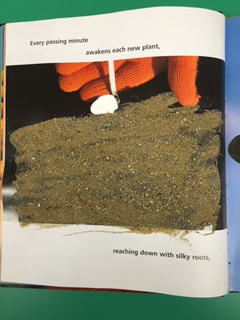 Read the book: How Many Seeds in a Pumpkin?
Read the book: How Many Seeds in a Pumpkin?- This is a wonderful book about a teacher that helps his students determine how many seeds in a pumpkin.
- It teaches students to feel the ridges on the outside of the pumpkin and tells them that there are pumpkin seeds on each ridge. There are other ways to “predict” which pumpkin may have more or less seeds.
After reading this story, we make predictions about a large pumpkin. (We make predictions very often in my class. I feel making predictions is a “safe” way to take risks and to also help the students understand the world around them.)
- Then, I cut the top off the pumpkin. We discuss how the pumpkin smells, etc.
- Students then take turns pulling the seeds out of the pumpkin. We discuss pulp and how it smells, feels, and we try to brainstorm vocabulary words to describe the inside of the pumpkin. We also compare the inside and outside of the pumpkin.
- I have 3 large paper pumpkins on the floor. (We do most lessons on the floor in a circle.) Each paper pumpkin is labeled: ones, tens, hundreds). I give each child small paper cups. Ten seeds are put in each small cup and placed on the “ones” pumpkin.
- When all the pumpkin seeds have been placed in cups we move the “tens” cups to the tens pumpkin.
- Then we count by tens to 100 and empty ten small cups into a larger cup and placed on the hundred pumpkin.
- After counting all the pumpkin seeds, we look at our predictions again, comparing who was the closest, etc.
This math lesson teaches: vocabulary, adjectives, comparing, describing, one to one correspondence, and place value. I love this lesson. This is when I am happy that I have a self-contained classroom, since I may teach this lesson all day and not during a “30 minute math block”.
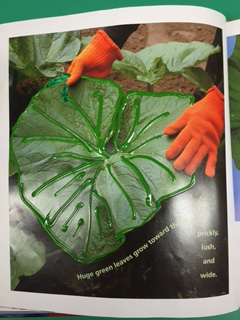 Science: Pumpkin Life Cycle
Science: Pumpkin Life Cycle
- I begin the lesson by reading the nonfiction book The Pumpkin Life Cycle. This is a very easy high interest book that students really enjoy.
- I have modified the book so it will be accessible to all my students. I actually glued seeds on the seed page (soil on the soil page, I used a glove to show the glove / hand in the book, foam shapes for stem with rough edges for the vines, curly pipe cleaners on the “tendrils”. I have used puffy paint on the pumpkins. I used globs of glue to try to produce the decomposing pumpkin) etc
- I have a second modified book that my student who is visually impaired can hold while I read to the class.
- After reading the book we discuss what a pumpkin needs to grow. We then experiment!
- Each student plants a pumpkin seed in a clear plastic cup so we can see the roots, etc.
- We journal and discuss daily.
- We also do my favorite year long experiment! This is my favorite! I use two clear plastic tubs with covers. We bury in soil a pumpkin we picked from our field trip. We water the pumpkin, put the cover on tight and put up high in a window with a lot of sun.
- We take another pumpkin about the same size and remove the seeds. (I usually bring them home and roast them for another lesson the next day.) We bury the pumpkin in the other tub. We put the cover on and place next to the pumpkin in the window.
- Every week we take the pumpkins down. We discuss how they look – it has changed shape, decomposing – favorite word – then we take the cover off and touch it – smell it (stinks!) etc.
- We journal in our science journal
- In the spring, we see that our pumpkin has sprouted etc. The pumpkin with no seeds didn’t. Why not?
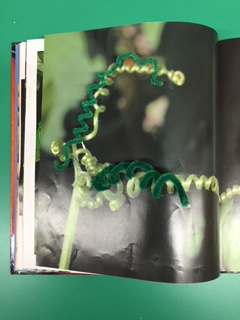
Common Core Standards
The following Common Core State Standards (CCSS) will be addressed in this unit:
English Language Arts & Math Common Core Standards:
- R1.K.1 With prompting and support, describe the connection between pieces of information in a text.
- R1.K.2a Recognize and produce rhyming words
- W.K.3 Use a combination of drawing, dictating, and writing to narrate a single event or several events, tell about the events in the order in which they occurred (In this case the life cycle of the pumpkin).
- SL.K.1/SL.K2 Participate in collaborative conversations with diverse partners about kindergarten topics & confirm understanding of information presented orally or through other media (in this case re-telling the story of the pumpkin life cycle).
- K.CC.4 Understand the relationship between numbers and quantities; counting to cardinality.
- K.MD.1 Describe measurable attributes of objects, such as length or weight. Describe several measurable attributes of a single object (In this case the amount of pumpkin pulp/seeds/circumference).
- K. CC.C.6 Identify whether the number of objects in one group is greater than, less than, or equal to the number of objects in another group.
- K.CC. 1 Count to 100 by ones and tens. (counting pumpkin seeds)
